Try our favorite, clean protein powder: See our top pick →
Try our favorite, clean protein powder: See our top pick →
This post contains links through which we may earn a small commission should you make a purchase from a brand. This in no way affects our ability to objectively critique the products and brands we review.
Evidence Based Research To fulfill our commitment to bringing our audience accurate and insightful content, our expert writers and medical reviewers rely on carefully curated research.
Read Our Editorial Policy
Vitamin C is among the most essential nutrients we need for the proper function of various processes that take place in our bodies.
From facilitating energy metabolism in our cells to collagen synthesis and immune system health, vitamin C does so much to keep us healthy.
Taking vitamin C supplements is one of the most convenient ways to intake larger doses of this essential vitamin, but is it the best?
There is evidence that dietary intake of vitamin C (e.g., eating more fresh fruits and vegetables) leads to better health outcomes.
However, in this review of the current literature on the subject, the conclusion essentially says more research is needed to determine whether vitamin C supplements or dietary vitamin C intake provide the most benefits.
With that being said, if you’re looking to improve your health and get more essential nutrients, eating a varied diet packed with fresh whole foods can only help you.
Sweet red bell peppers have the highest concentration of vitamin C per serving of any fruit or vegetable.
To get the most nutritional benefits from this delicious veg, you should eat it raw because vitamin C is easily destroyed by heat.
We recommend you add it to sandwiches for an extra crunch or dip it in hummus for a protein and nutrient-packed snack.
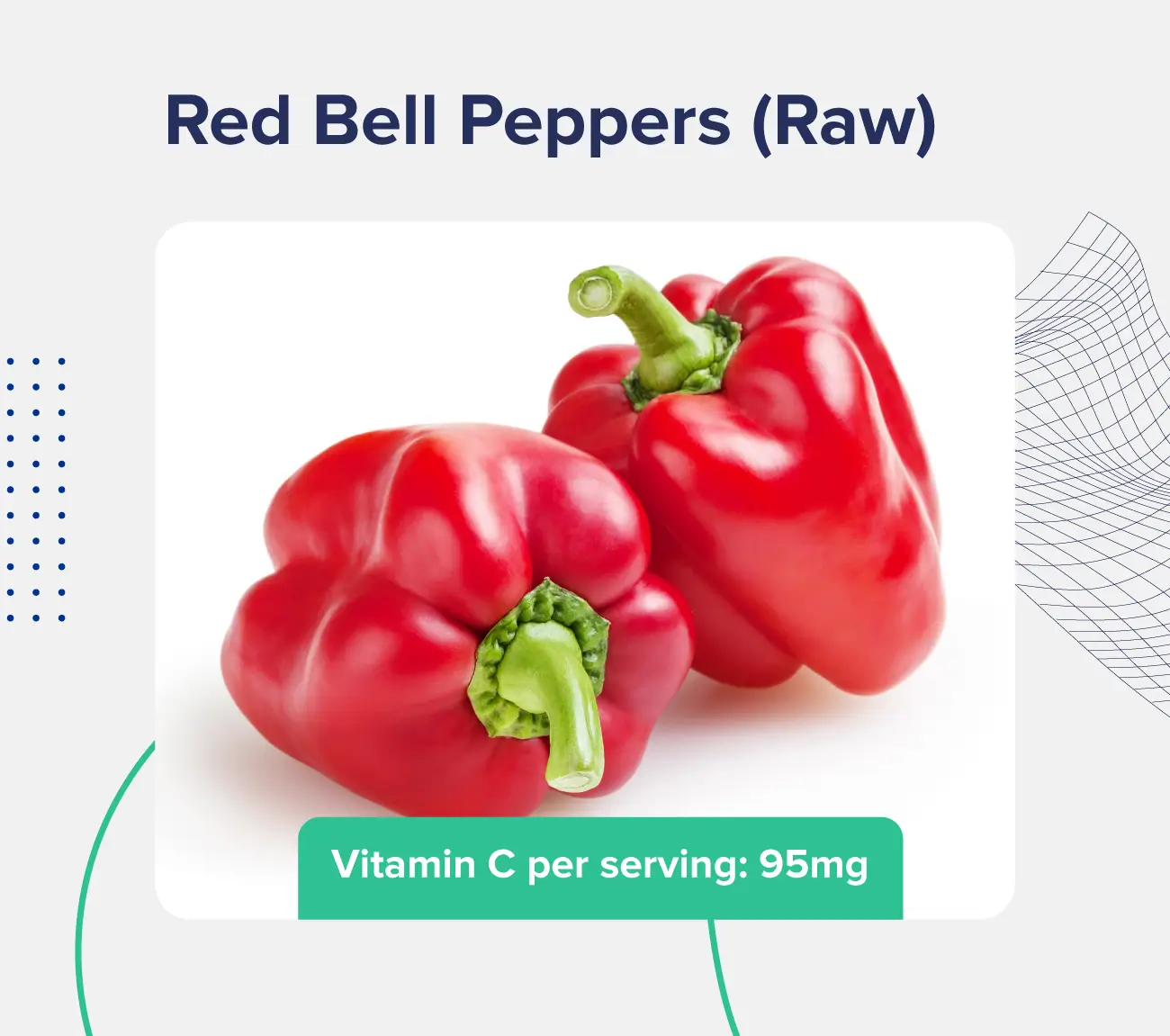
Serving Size: ½ Cup or 90g
Calories: 23
Mg of vitamin C per serving: 95mg
Percent DV: 106%
Other nutrients: vitamin A, vitamin B6, folate (vitamin B9), and vitamin E.
Orange juice is one of the easiest ways to get in your daily serving of vitamin C alongside a healthy breakfast.
It’s also often fortified with vitamin D, making it a good choice for those dreary winter months when you might not get enough sun.
Consider occasionally eating whole oranges instead of orange juice since they have less sugar per serving.
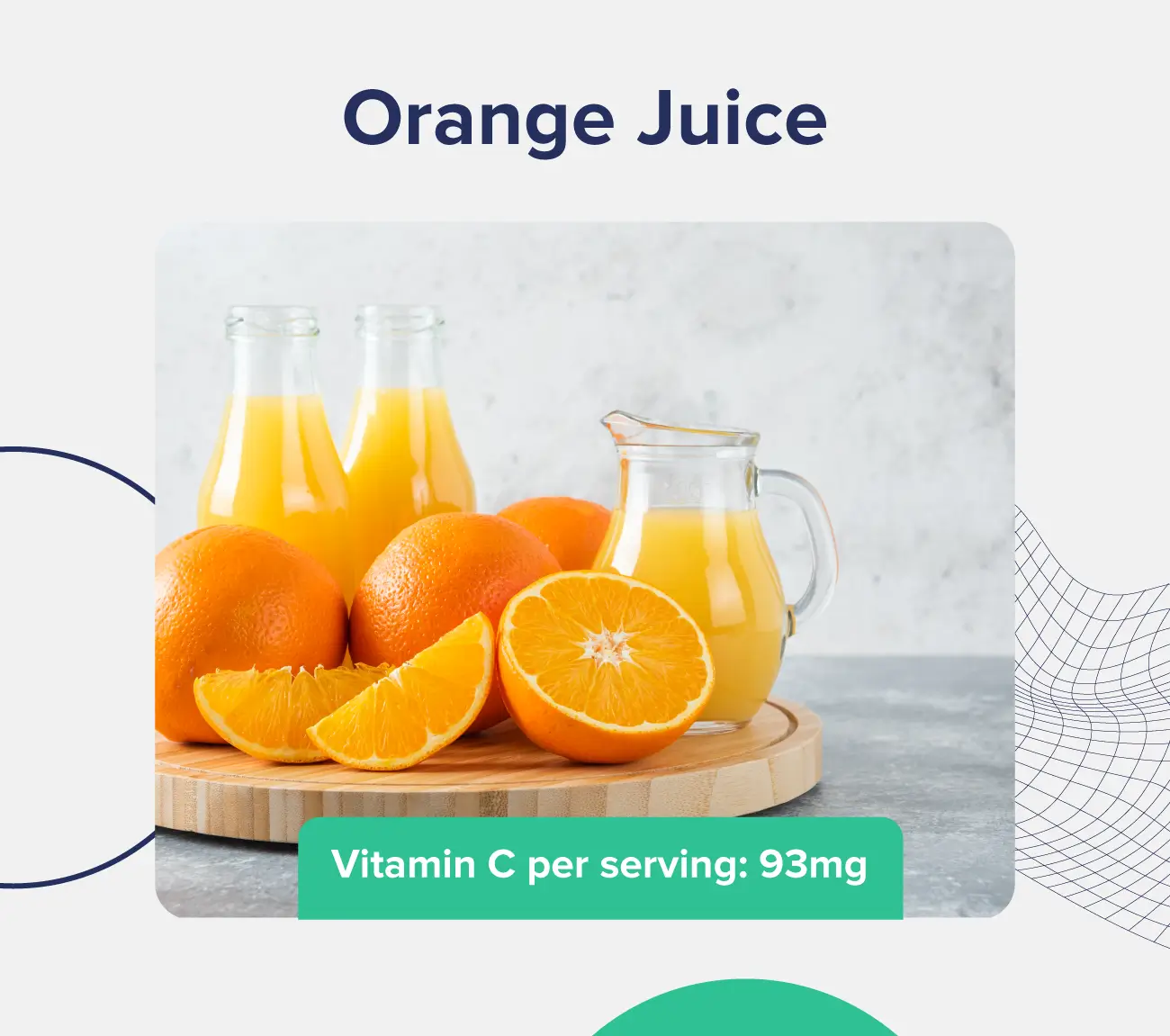
Serving size (juice): ¾ Cup or 177ml
Calories: 84
Mg of vitamin C per serving: 93mg
Percent DV: 103%
Serving size (fruit): 1 medium
Calories: 84
Mg of vitamin C per serving: 70mg
Percent DV: 78%
Other nutrients: vitamin D (when fortified), folate, potassium
Grapefruits are a love-it-or-hate-it fruit. They’re not for everyone.
That said, they are a fantastic source of vitamin C, with almost an entire daily serving of vitamin C per fruit or ¾ cup of grapefruit juice.
Add grapefruit juice to a bubbly mocktail or have some fruit as a snack or with breakfast for a nutritious bump in vitamin C.
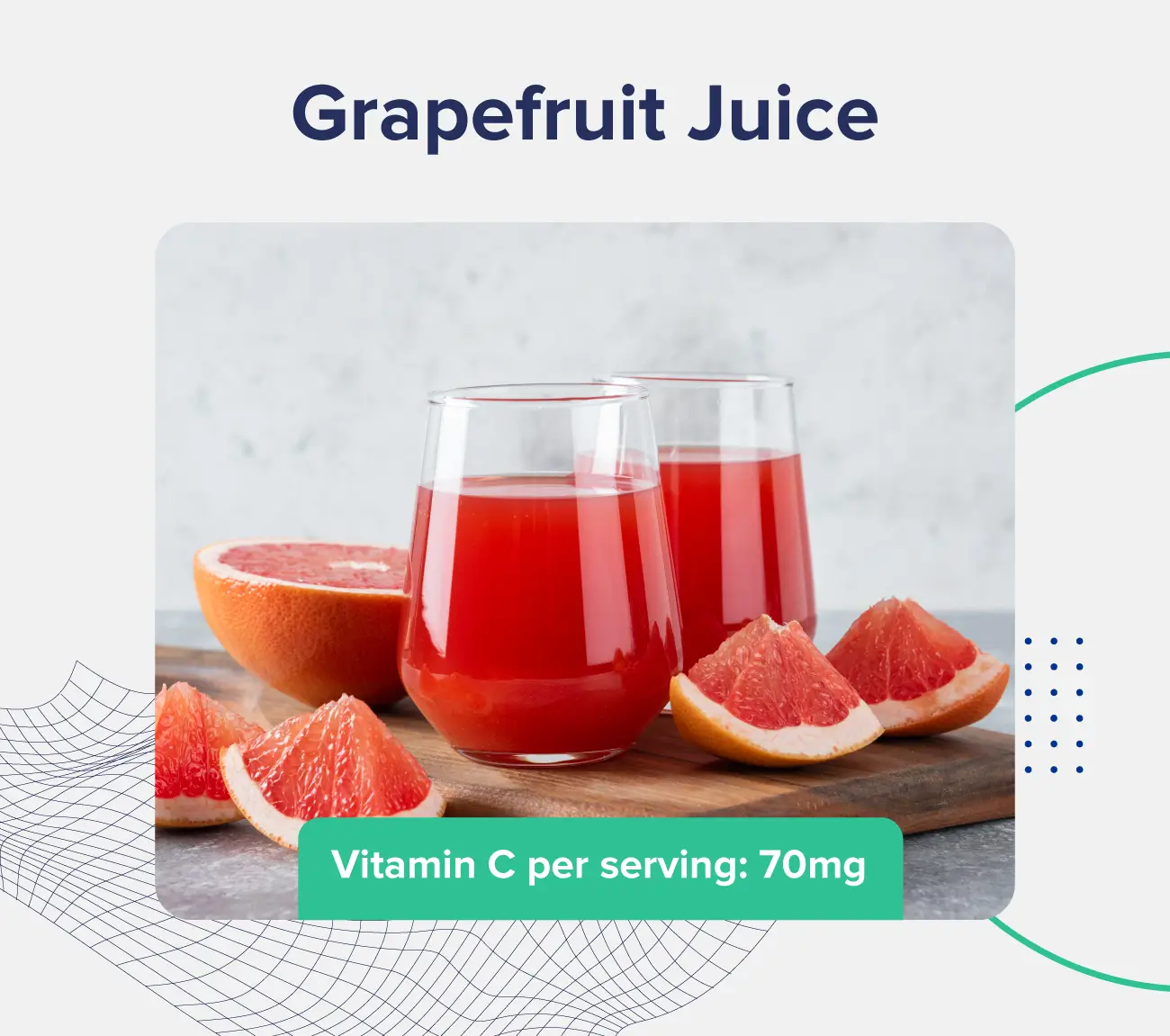
Serving size (juice): ¾ Cup or 177ml
Calories: 70
Mg of vitamin C per serving: 70mg
Percent DV: 78%
Serving size (fruit): 1/2 medium
Calories: 26
Mg of vitamin C per serving: 39mg
Percent DV: 43%
Other nutrients: potassium, magnesium, flavonoids
Did you know that kiwis are classified as berries? You learn something new every day!
Like other berries, this delicious fuzzy fruit is also packed with vitamin C.
Just one medium fruit has 71% of your daily serving of this essential nutrient.
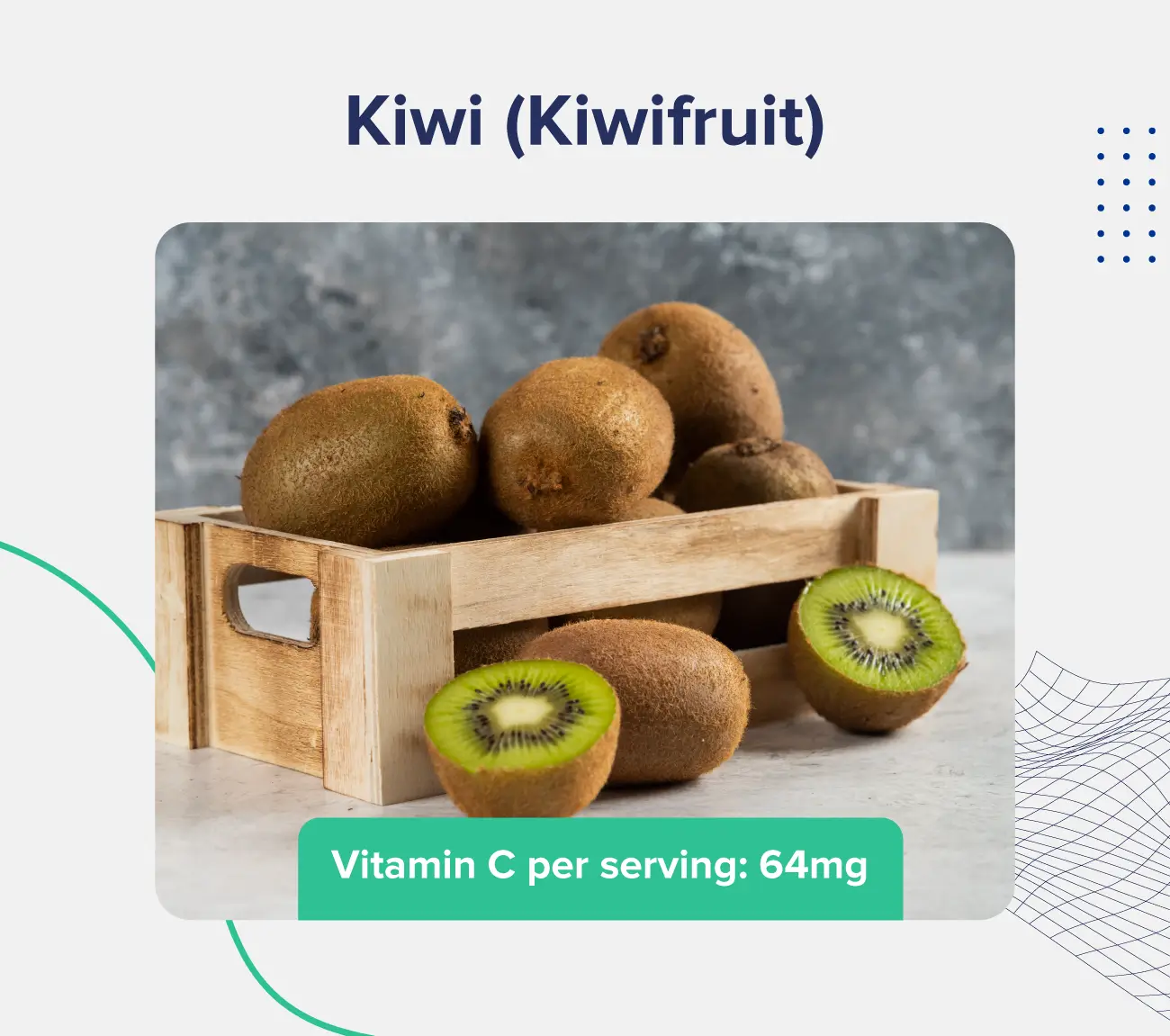
Serving size: 1 medium
Calories: 42
Mg of vitamin C per serving: 64mg
Percent DV: 71%
Other nutrients: vitamin E, vitamin K, folate, copper
Like their other colorful sibling, green bell peppers are also a fantastic source of vitamin C.
Though you’ll typically find green bell peppers on pizza, eating them raw alongside dips or in salads better preserves their vitamin C content.
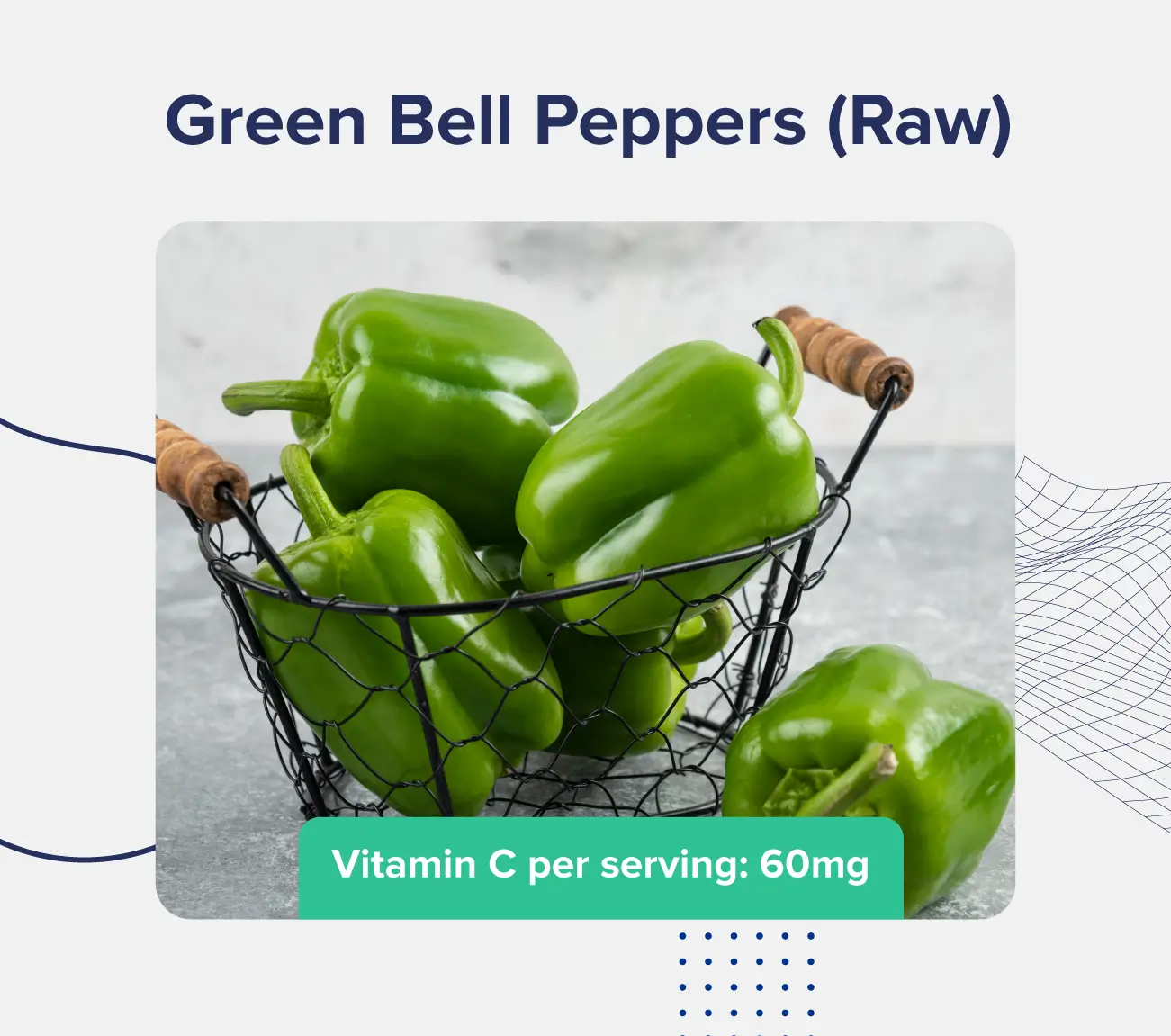
Serving size: ½ cup or 90g
Calories: 15
Mg of vitamin C per serving: 60mg
Percent DV: 67%Other nutrients: vitamin K, potassium, vitamin B6
Broccoli might be your kid’s worst enemy, but its nutrient content will be their best friend to help them grow big and strong.
We know this probably won’t convince them to eat it, but it’s worth a try!
Eat broccoli cooked or raw to reap the health benefits of this tree-like vegetable.
We recommend trying our broccoli crunch salad or roasting the broccoli (as opposed to boiling or steaming) to help retain its vitamin C content, along with all the other nutrients it’s packed with.
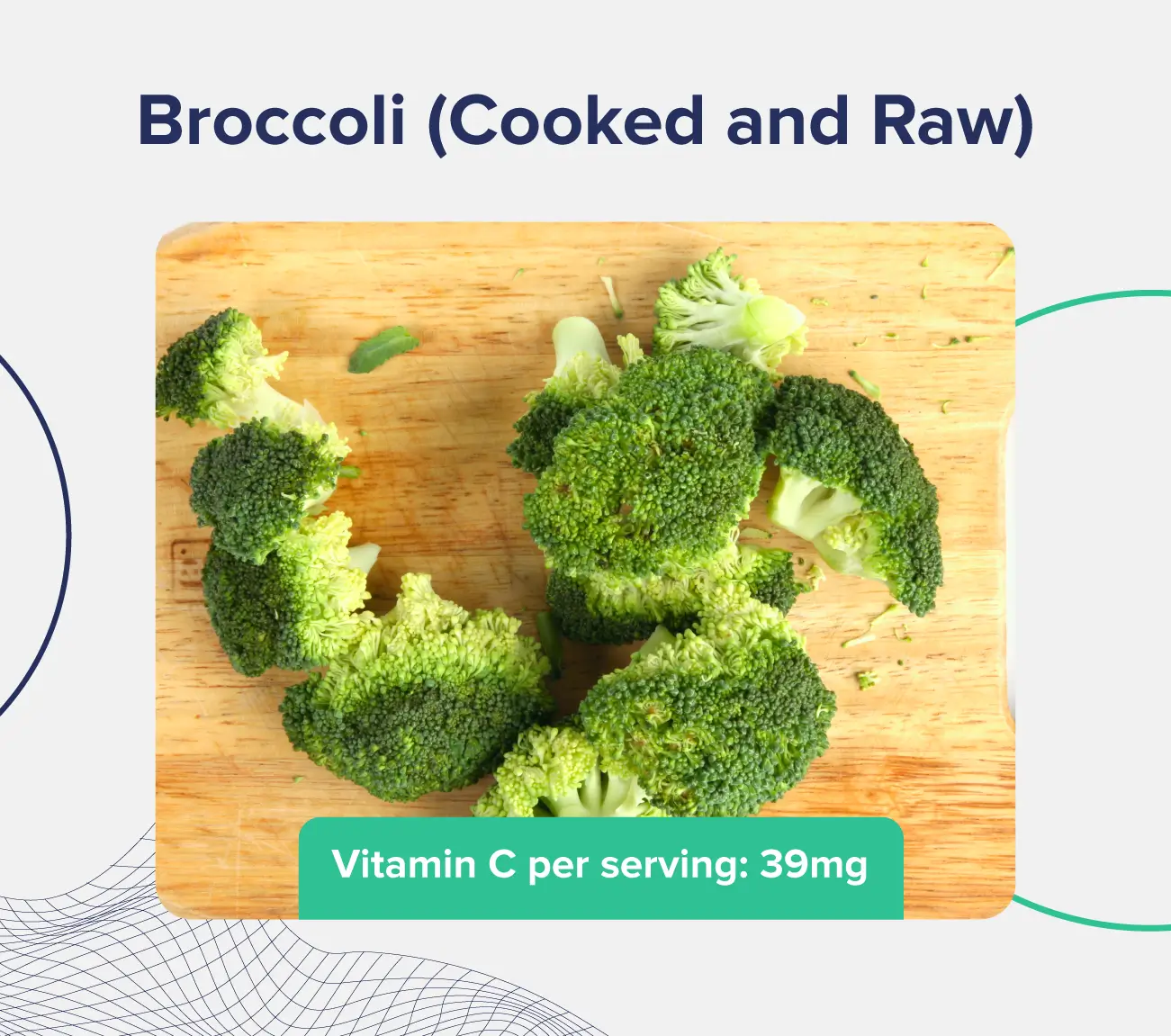
Serving size: ½ cup or 45g
Calories: 17
Mg of vitamin C per serving: 39mg
Percent DV: 43%Other nutrients: iron, magnesium, vitamin B6, calcium
Whether you eat them in your yogurt, on their own, or add them to a salad to add a bit of sweetness, strawberries are the perfect fruit––and not just for their taste but their nutrient content, too.
Just half a cup of strawberries (about 4 medium-sized berries) can satisfy half of your daily serving of vitamin C.
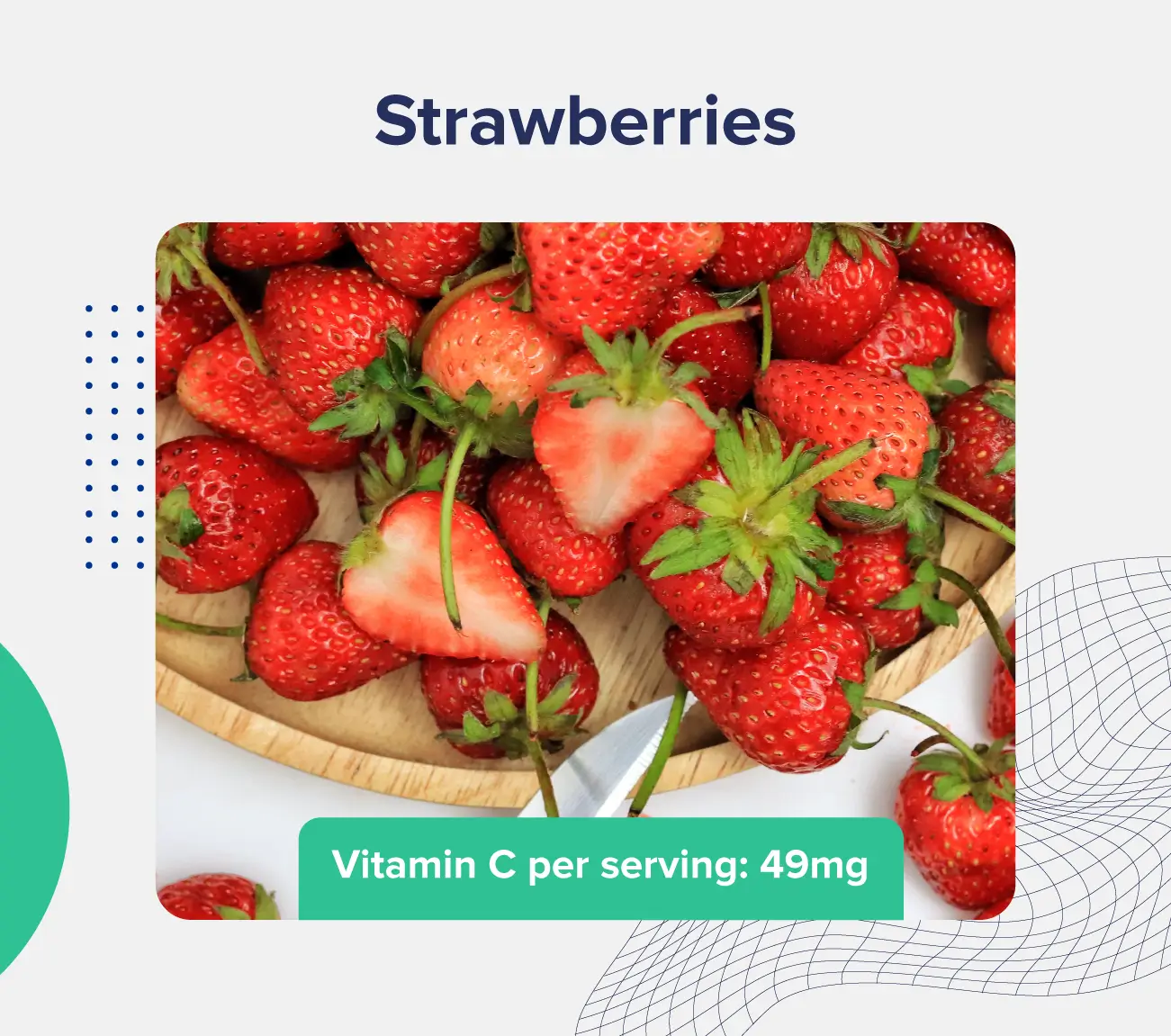
Serving size: ½ cup or 50g
Calories: 33
Mg of vitamin C per serving: 49mg
Percent DV: 54%
Other nutrients: manganese, folate, potassium
Brussels sprouts have experienced a bit of a renaissance in recent years as many have realized they don’t have to be tasteless, bitter balls of leaves.
Nowadays, plenty of recipes explain exactly how to make these a satisfying side for any meal.
Roast them in the oven with a drizzle of olive oil and seasonings, or throw some bacon into the sautee pan as you cook them––if this doesn’t make you a sprouts believer, nothing will.
Best of all, you can get your whole daily serving of vitamin C with just a handful of Brussels sprouts.
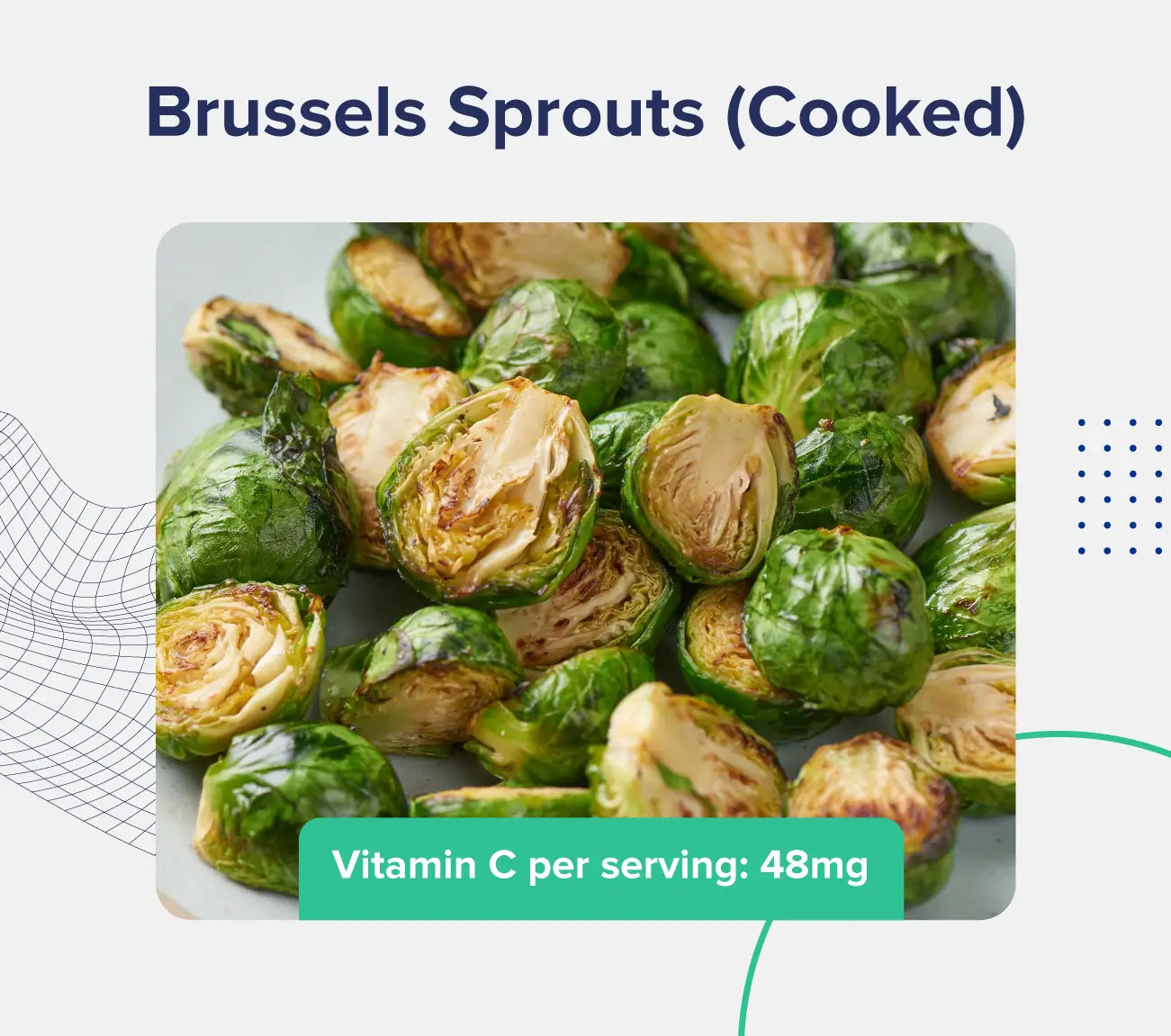
Serving size: ½ cup or 78g
Calories: 28
Mg of vitamin C per serving: 48mg
Percent DV: 53%Other nutrients: iron, vitamin B6, magnesium
Some might assume that the health benefits of tomato juice begin and end with a Bloody Mary––commonly espoused as a hangover cure.
And while we don’t recommend using “hair of the dog” to try and cover for last night’s bad decisions, there may be some truth to this drink’s supposed healing properties.
Tomatoes and tomato juice are packed with beneficial nutrients, and some studies suggest it may even boost your liver function.
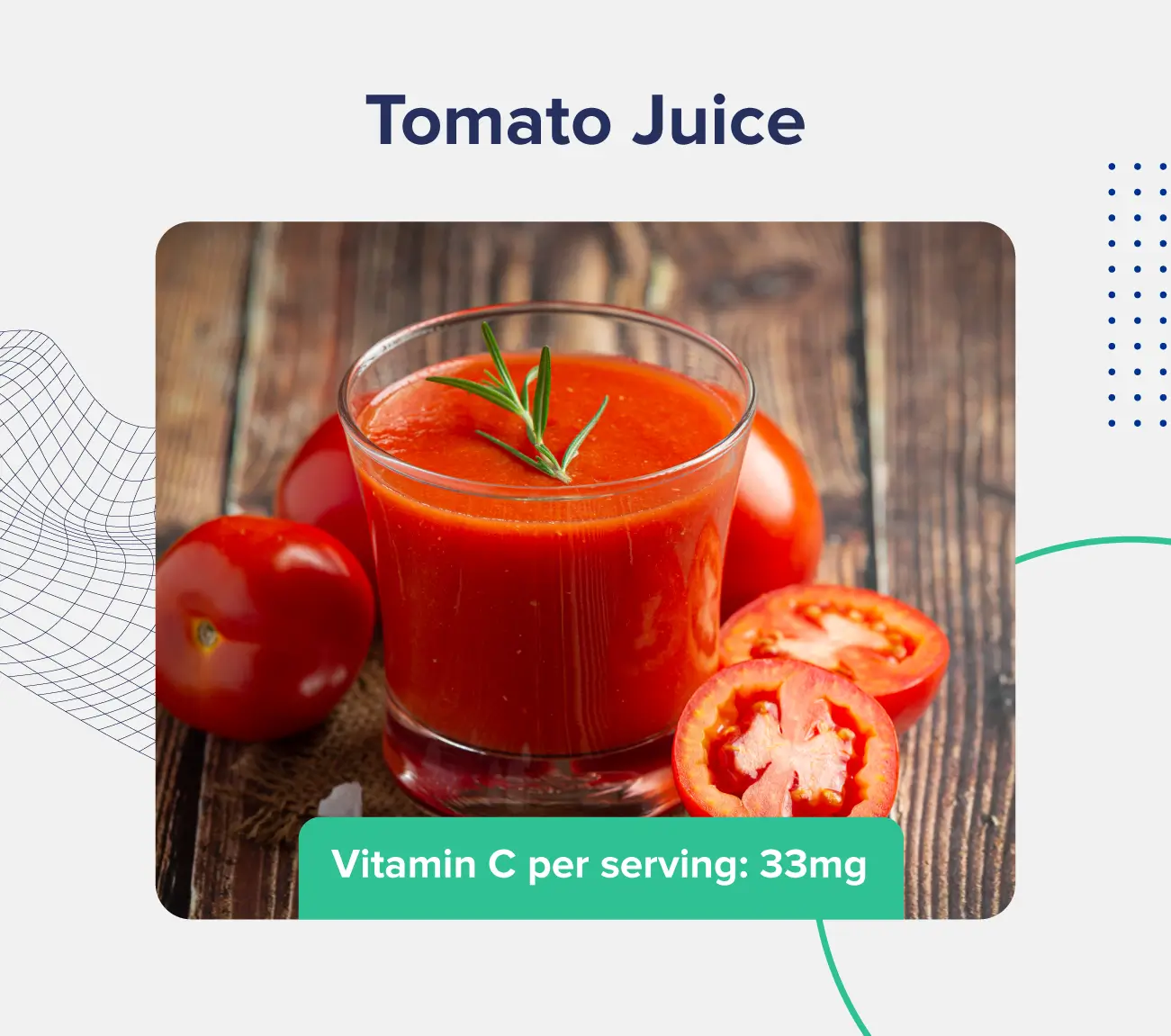
Serving size (juice): ¾ cup or 177ml
Mg of vitamin C per serving: 33mg
Percent DV: 37%
Serving size (fruit): 1 medium
Mg of vitamin C per serving: 17mg
Percent DV: 19%
Other nutrients: vitamin A, vitamin K, thiamine, niacin, folate, vitamin B6, potassium, magnesium, manganese, copper
Cantaloupe is more than just a great summer fruit! It’s also full of vitamin C and other essential nutrients.
Besides a healthy dose of vitamin C, cantaloupe is also a good source of vitamin A, with one serving accounting for nearly half your daily recommended intake.
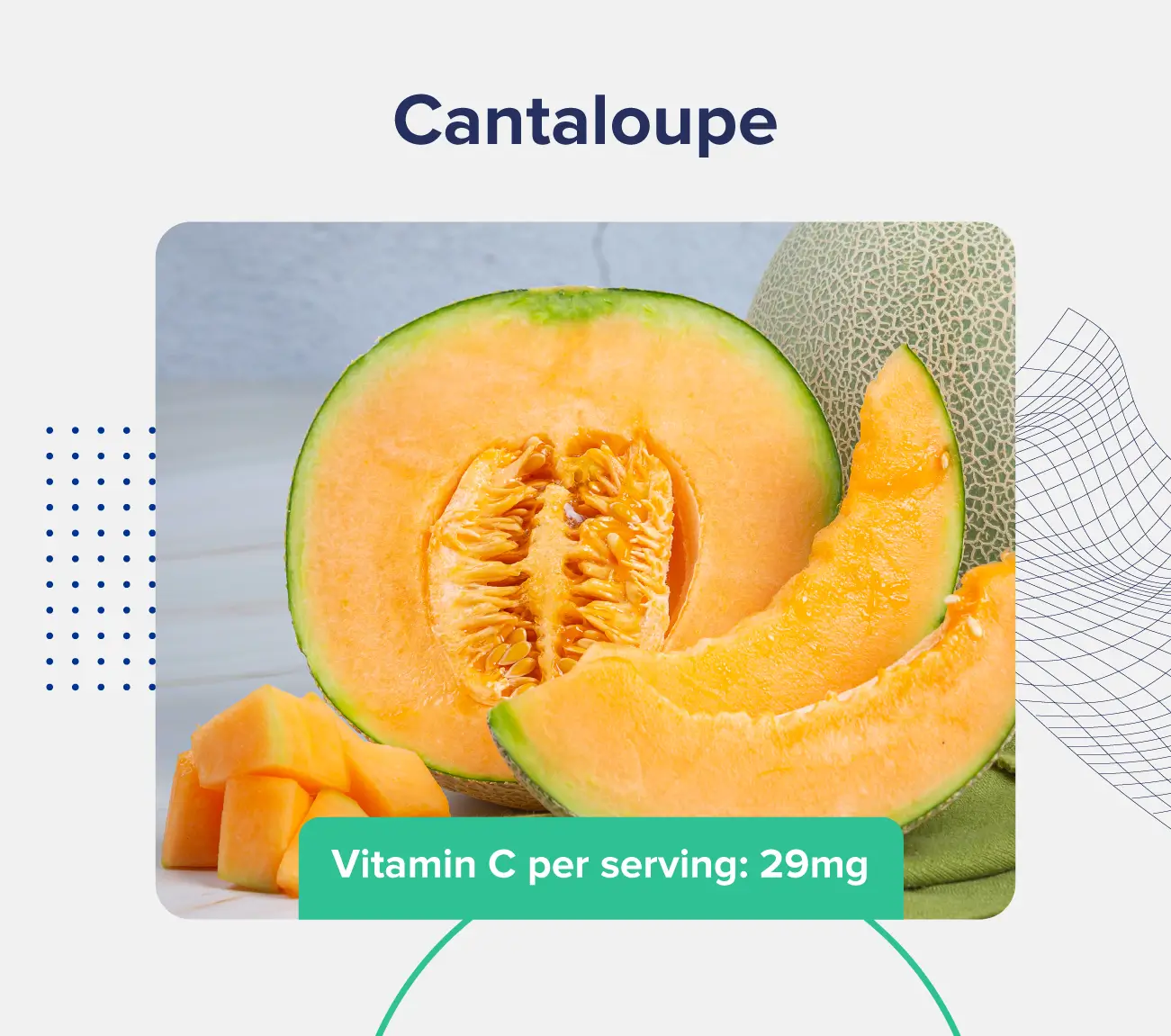
Serving size: ½ cup or 78g
Calories: 27
Mg of vitamin C per serving: 29mg
Percent DV: 32%
Other nutrients: vitamin A, magnesium, iron, vitamin B6, calcium
Cabbage belongs to a family of vegetables called cruciferous vegetables.
This group includes broccoli, Brussels sprouts, and cauliflower, which are also high in vitamin C and many other essential nutrients and powerful antioxidants.
In cabbage’s fermented form, sauerkraut, you can get additional digestive and immune system benefits if consumed in moderation.
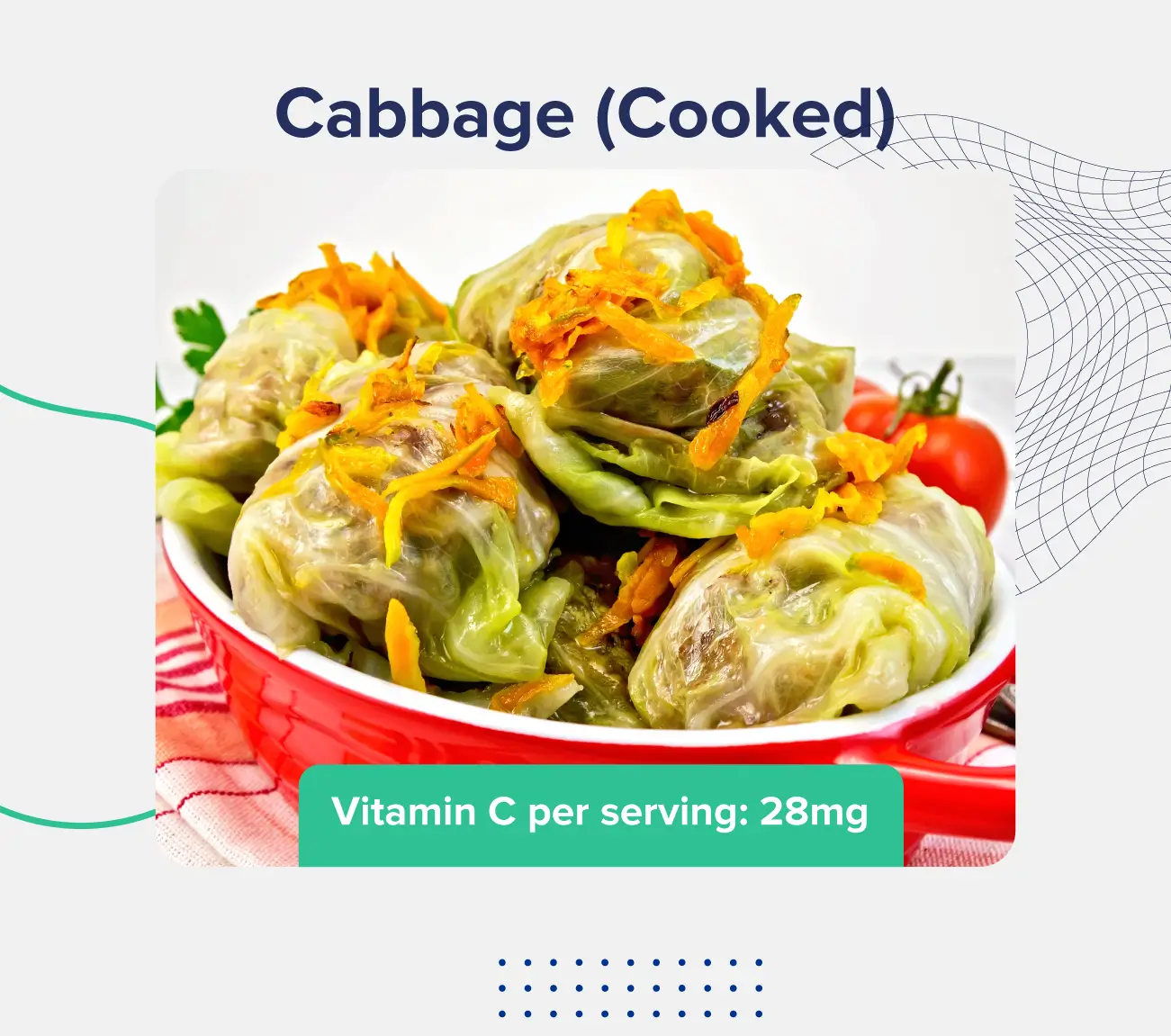
Serving size: ½ cup or 75g
Calories: 17
Mg of vitamin C per serving: 28mg
Percent DV: 31%
Other nutrients: vitamin K, folate, manganese, vitamin B6, calcium, potassium, magnesium
Cauliflower is another vegetable that has earned some much-deserved recognition for its versatility as a substitute for a variety of foods for people looking to reduce their carbohydrate intake.
On top of reducing calorie intake from carbs, cauliflower also provides better nutritional benefits (though primarily in its raw form) compared to rice or breadcrumbs.
Try our cauliflower fried rice recipe if you want to start eating more of this vegetable!
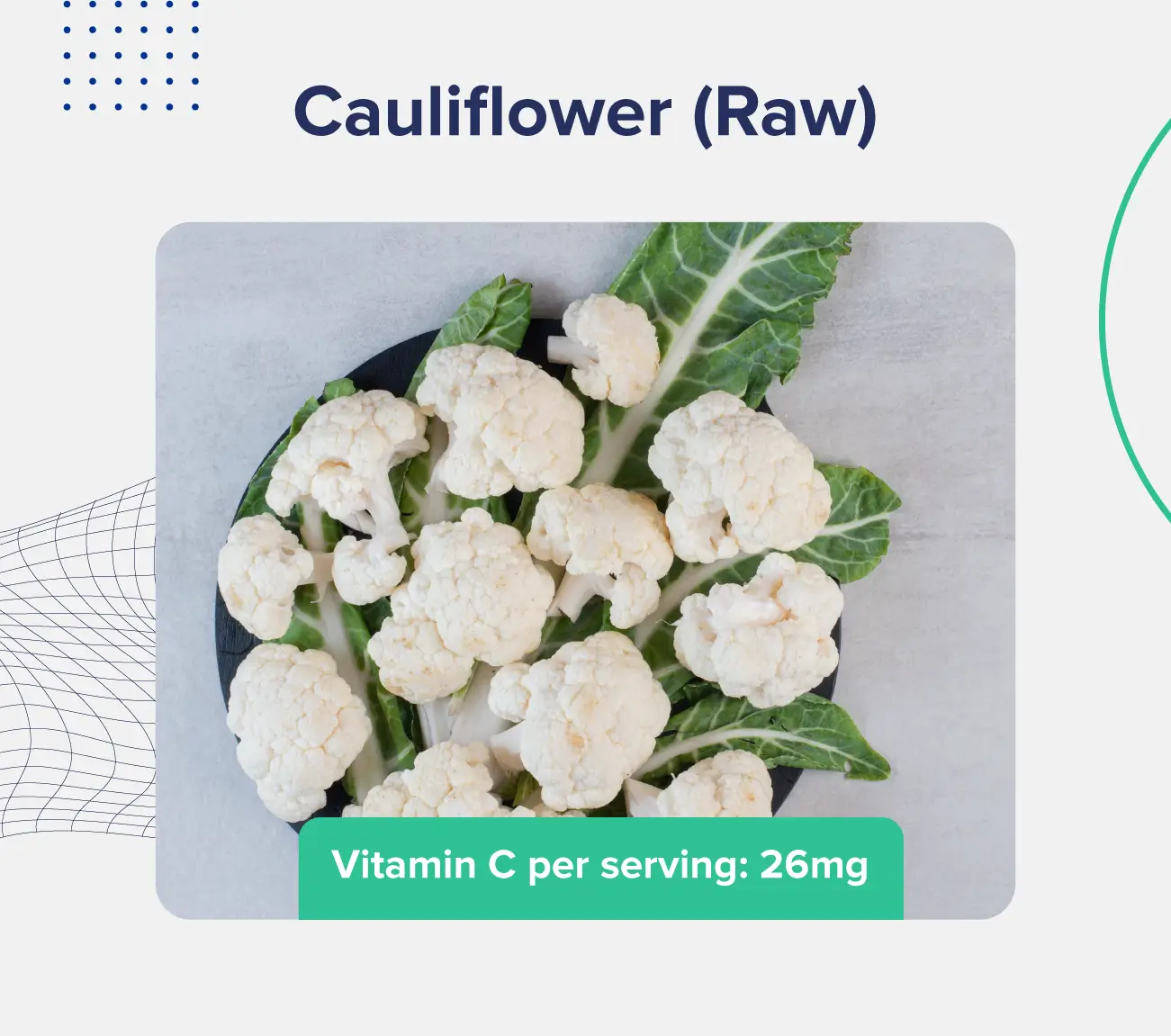
Serving size: ½ cup or 165g
Calories: 15
Mg of vitamin C per serving: 26mg
Percent DV: 29%Other nutrients: iron, vitamin B6, magnesium, calcium
As nutritious comfort foods go, the potato is hard to beat.
From french fries to mashed potatoes and everything in between, this versatile vegetable deserves every bit of attention it gets.
On top of being one of the most affordable foods with vitamin C content, potatoes contain lots of other nutrients, too, such as potassium and vitamin B6.
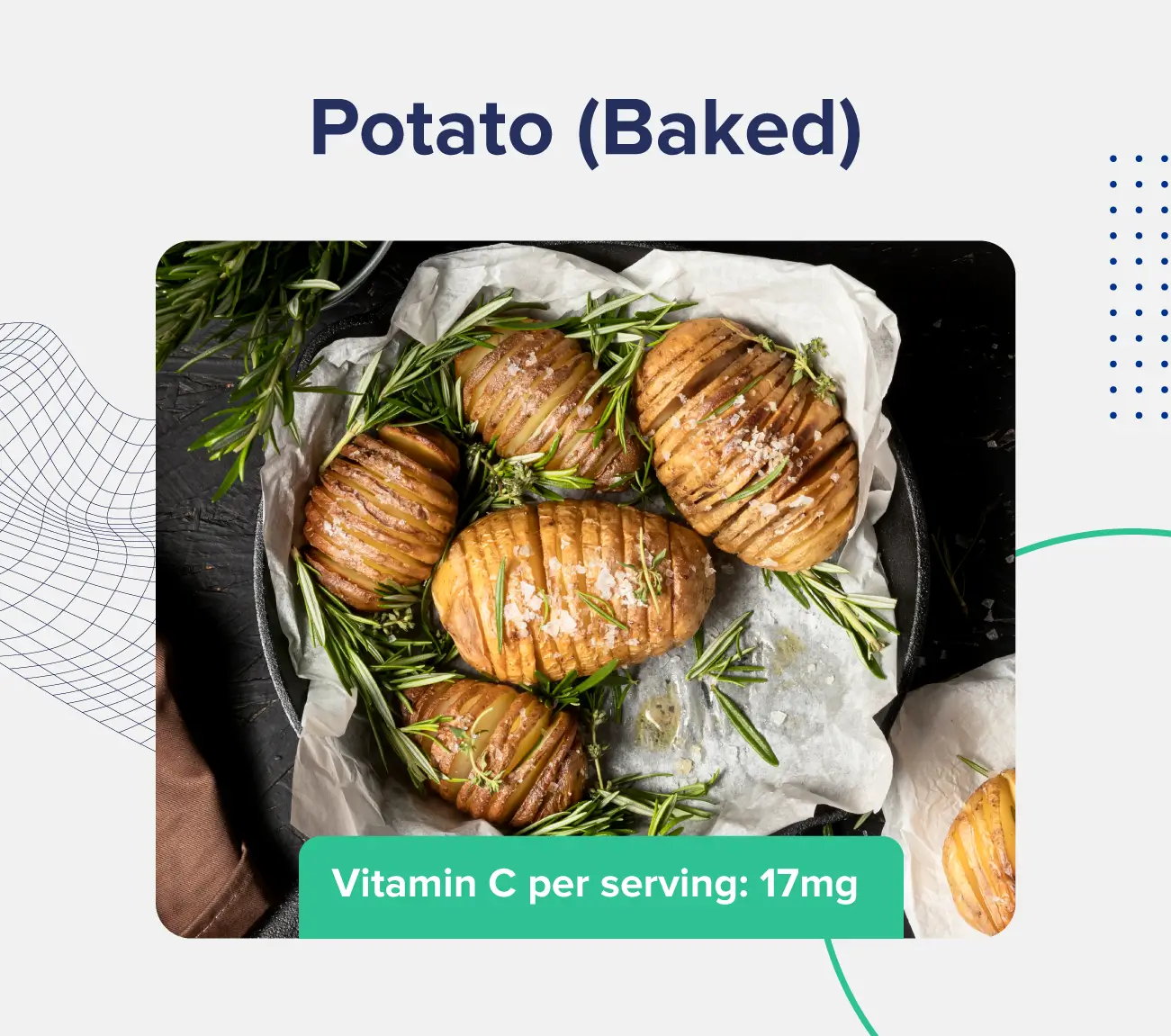
Serving size: 1 medium or 175g
Calories: 110
Mg of vitamin C per serving: 17mg
Percent DV: 19%Other nutrients: iron, potassium, vitamin B6, calcium
While spinach isn’t as impressively high in vitamin C as its other counterparts on this list, it makes up for this by being the jack of all trades of vegetables.
As the king of dark leafy greens, spinach is full of nutrients such as vitamin A, vitamin K, iron, folate, and potassium.
You also get more of these essential vitamins with fewer calories, so this is an excellent option if you’re cutting back a bit but want to keep up your nutrient intake.
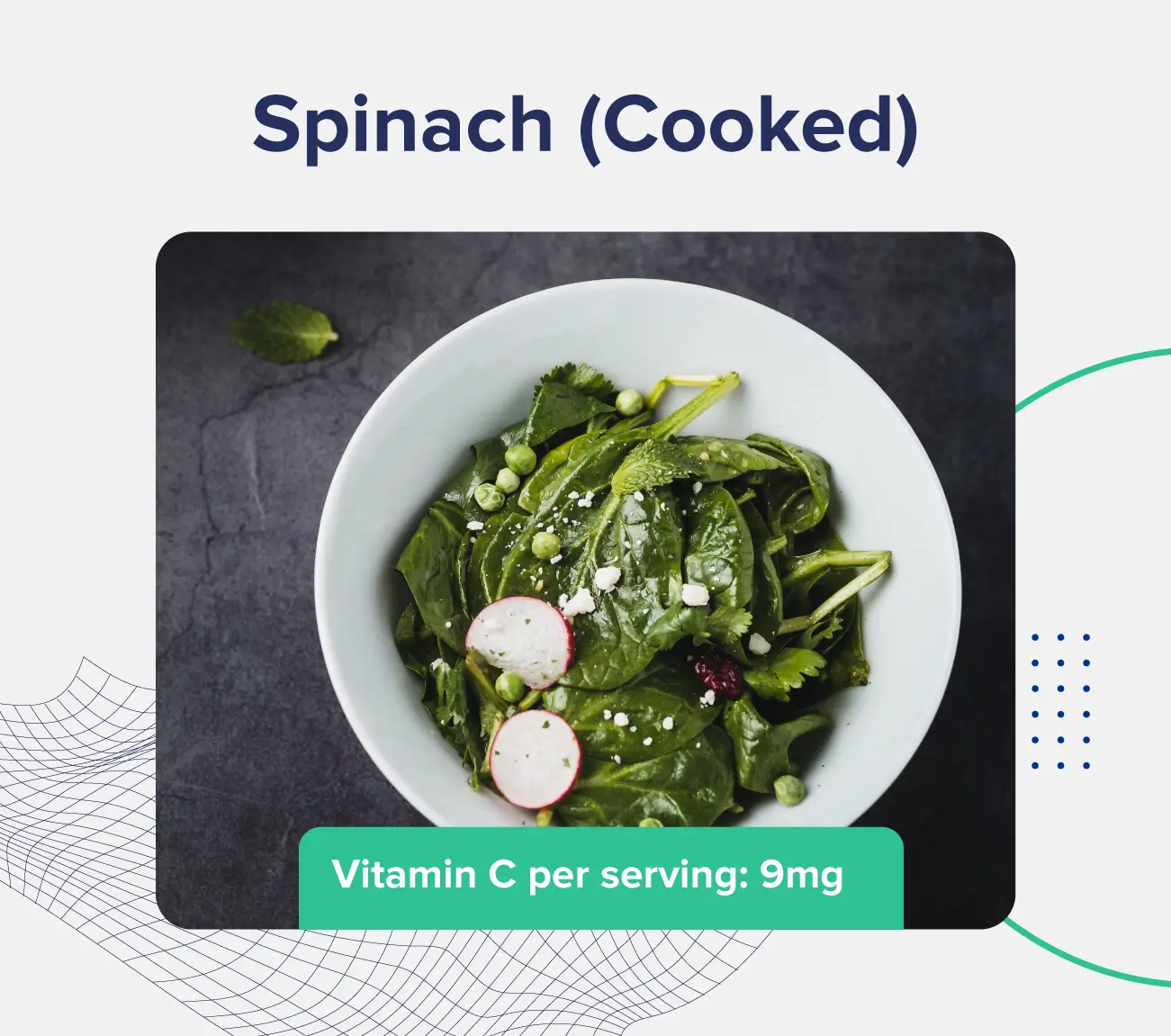
Serving size: ½ cup or 112g
Calories: 21
Mg of vitamin C per serving: 9mg
Percent DV: 10%
Other nutrients: vitamin A, vitamin K, iron, folate, potassium
Last but not least, the humble green pea.
Serve it in savory summer salads or cook up some split pea soup for a healthful dose of nutrients, complex carbohydrates, fiber, and protein.
This legume can truly do it all!
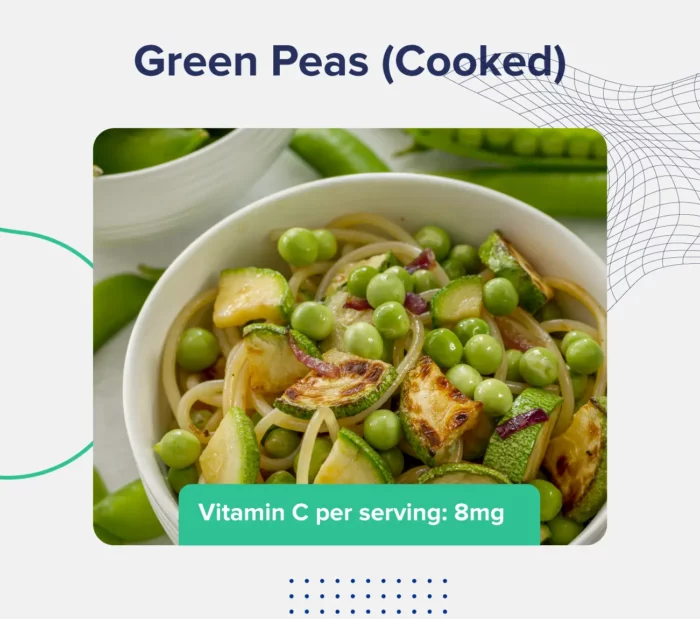
Serving size: ½ cup or 72.5g
Calories: 67
Mg of vitamin C per serving: 8mg
Percent DV: 9%Other nutrients: vitamin K, vitamin A, potassium, iron, magnesium, manganese, zinc, folate, B vitamins
Vitamin C (l-ascorbic acid) is essential for a healthy immune system, cellular health, iron absorption, energy metabolism, wound healing, and collagen production.
However, mounting evidence shows that raising your plasma vitamin C levels (the amount of vitamin C present in your blood) can lead to additional health benefits from its antioxidant properties, improve immune system response against illnesses, and reduce perceived levels of fatigue and stress.
The effects each individual will feel from consuming vitamin C supplements or increasing dietary intake will vary depending on whether or not you are deficient.
However, higher doses of vitamin C can improve immune function––reducing the length and severity of illnesses like the common cold––and reduce fatigue resulting from mild to moderate vitamin C deficiency.
Most of the literature and studies on vitamin C and its benefits agree that dietary intake (as opposed to just supplementation) leads to more significant health benefits since you will likely consume more nutrients overall with an improved diet.
Amount of vitamin C you should be consuming daily (pregnant and breastfeeding is more)
An adequate intake of vitamin C is at least 75 to 90mg per day for women and men, respectively.
If you are pregnant or breastfeeding, you should increase this by at least half––85mg if pregnant and 120mg if breastfeeding.
However, even a slightly increased dietary intake of vitamin C to between 100 to 200mg could help further improve immune system function.
The upper limit of vitamin C intake for adults is 2,000mg per day.
Doses above this amount can interfere with certain medications and cause some side effects, such as upset stomach, diarrhea, and, rarely, kidney stones.
Vitamin C is a water-soluble vitamin, meaning that it is dissolved in water and is easily absorbed into the body. However, like every other water-soluble vitamin, this makes it a bit harder for our bodies to hold onto vitamin C, so we must constantly eat it to keep our levels at an appropriate level. No foods help improve this absorption, per se, but eating some foods raw, such as bell peppers and cauliflower, can preserve the available nutrients.
The food highest in vitamin C per serving is red bell peppers. One ½ cup serving contains 106% of your recommended daily vitamin C.
Eggs contain many vitamins and other nutrients, but they do not have any vitamin C. This could be because chickens can synthesize vitamin C from glucose.